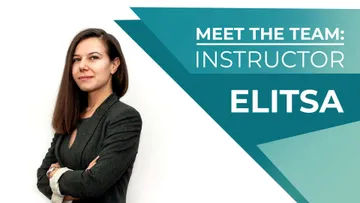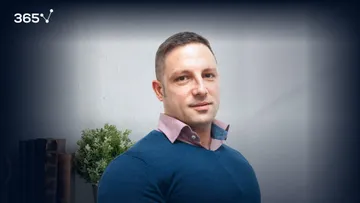Viktor Mehandzhiyski, Instructor at 365 Data Science

Viktor Mehandzhiyski graduated from the Model High School of Mathematics in Plovdiv, Bulgaria, and went on to pursue a double degree in Mathematics and Economics in Hamilton College, New York.
Some of the courses he took during his studies include Linear & Abstract Algebra, Analysis, Multivariate Calculus, Probability Theory, Differential Equations, and Mathematical Modelling. Viktor also has strong analytics background which stems from his Statistics, Econometrics, Financial Time-Series Econometrics and Behaviour Economics education. His coding experience includes working with C, C++, and Python, as well as the more math/econ-oriented MATLAB and STATA.
In addition, Viktor has spent every summer since 2014 teaching math to middle and high school students as a private tutor. Moreover, he has helped high school senior and graduate students with their SAT and Calc 1 preparation.
Viktor describes himself as a “Bachelor of Science and overall cool guy”, and we couldn’t agree more.
Hi Viktor, great to have you as an interview guest. Let’s start with a classic opening question. What do you do at the company?
Not much, I’m usually the guy that changes the water cooler bottles. Jokes aside, I’m a content creator here at 365, so I decide what topics to include in some of our courses and, you guessed it, create the content for them.
Classic Viktor humor! Seriously, though, can you tell us more about the courses you teach at 365 Data Science?
Well, I teach a course on the Probability course which is part of the 365 Data Science Program. There’s a very fine line between Probability and Statistics, so I try to show as much of the non-spreadsheet types of probability as I can. Of course, I avoid going too deep into the pure mathematics side of things, where proof-writing and calculus get involved. That is because this is a “fundamentals” course and for many of our students this is their first grasp of such topics. So, assuming they have the necessary mathematics background is unreasonable.
Sounds like an interesting and, at the same time, challenging course to teach. That makes us super curious to find out - what's the project you're working on right now?
Currently, I’m developing a course for Time Series Analysis, or TSA for short.
My expertise is mostly relevant to the financial side of things, so that’s the sort of data and analysis I’m focusing on.
However, you can easily apply the tools I’m using to non-financial data and still achieve the desired goals. The main focus of the course consists of analysing the data and trying to find patterns, which we can project into the future. In short, we’ll be trying to learn from the past in an attempt to predict the future. Sounds exciting, doesn’t it?
Author's note: The Time Series Analysis in Python course that Viktor mentions here is available on the 365 Data Science platform.
Absolutely! And how do you help your students through the learning process?
Well, I like to bring the “fun” in “fundamentals” as I try to explain complicated topics in probability using relatable real-life examples. These include anything from sports outcomes to eating pizza, which makes the entire experience more enjoyable and less intimidating.
Additionally, I try to provide them with enough quizzes, exercises and course notes, so they can practice all the new skills they’ve learned. Other than that, I try using visual aids like graphs and tables to help them perceive the new information the same way I do. Once that happens, it’s up to me to make sure I understand the topics well enough to ELI5 the new concepts.
I think it’s remarkable how you manage to make complex concepts really easy to digest. Now let’s talk about your academic background, Viktor. You hold a bachelor’s degree in Economics and Maths. What inspired you to take up Mathematics in the first place?
Ah, math was my very first love. We met when I was still in elementary school and we’ve had an on-and-off relationship ever since. To be perfectly honest, my mother set us up. She's an engineer by credentials, but a teacher at heart, so she introduced me to the field of numbers early on. She was also my very first tutor and her love for mathematics was contagious. It’s fair to say that without her affinity for the precise sciences, I would have never pursued a degree in mathematics.
Did your Mathematics background help you when you first started learning data science? And can you tell us more about how your interest in working with data evolved?
Most definitely!
Truth be told, I was fascinated by coding algorithms and how they worked since around the age of 11.
That’s also when I first got into coding since it felt like doing complicated math with a friend, who has immeasurable computing capacity. Of course, I probably wouldn’t have used those exact words 12 years ago, but you get the idea.
After pursuing different interests throughout high school, I rediscovered my love for coding in college. Parallel to that, I was introduced to statistics and their applications in Economics. The more papers I read through, the more I wanted to know how to conduct such an analysis on my own. In a way, it was my child-like fascination of the insights from academic papers, that made me want to see how all of this is determined. The more I worked with data, the more I wanted to let the computer do all the heavy lifting whilst I come in at the end and interpret the results.
And so, here we are.
You’ve got thousands of students. But have you had your 15 minutes of fame yet?
I mean, not really. However, I’ve been the center of attention for several memorable events in my life.
The first one was in high school when I dressed as a ballerina for a talent show. The skirt, the shoes, the whole 9 yards. I was reluctant to participate at first, but since my classmates chose me as their champion, I couldn’t let them down. Overall, our performance was much like the 2016 Warcraft movie – loved by the audience, loathed by the critics, or the teachers in our case. In the aftermath of the event, I was popular as the “ballerina dude” for a few months, so that was cool, I guess.
The second time I got a glimpse of fame was during my sophomore year in college. On Halloween 2015 I dressed as John Cena. At every party me and my friends visited that night, the moment we entered the room, the DJ would pause whatever he was playing and play my theme song. Everybody would go wild and line up so I can give them high-fives as if I was running to the ring. That night really made me consider changing my career path to wrestling, but I decided to go with my gut.
Viktor, we love your sense of humor. So, to conclude the interview, can you share your favorite joke with our readers?
I’m more of a spur-of-the-moment pun kind of guy, but I do have some jokes stored up in my repertoire. I love jokes you can tell little kids because those are really the ones that stay with them as they grow up. Or at least that’s how it was for me, I don’t know.
Q: What’s black & white, black & white, black & white, black & white, black & white?
A: A penguin rolling down a hill.
Q: What’s black and white laughing?
A: The penguin that pushed him.




